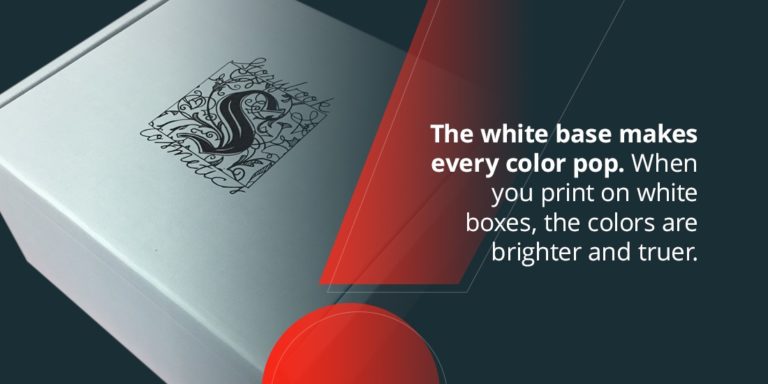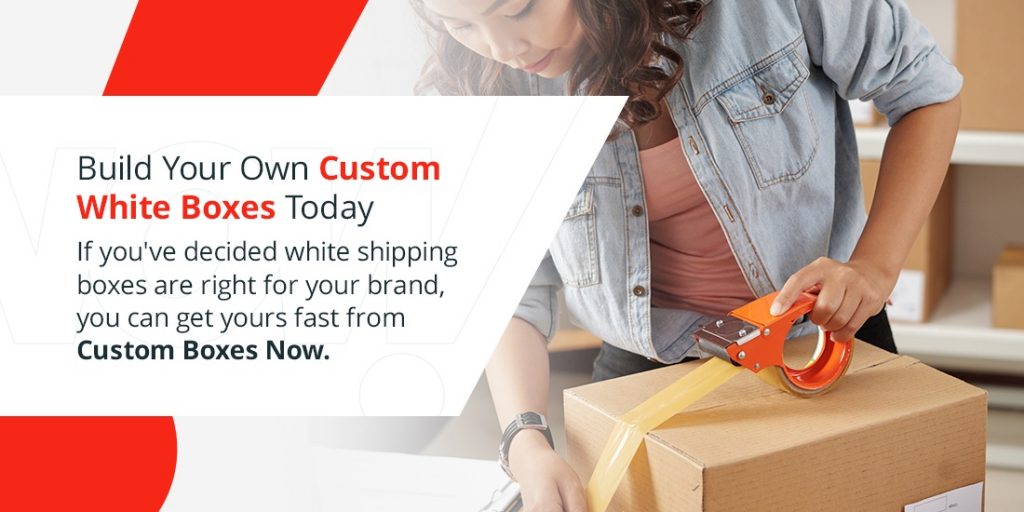
Any business that ships products to customers knows how important the box is. The humble corrugated cardboard box is the first line of defense for a product in transit. A thick wall of corrugation cushions and protects what’s inside, so it arrives as expected. There’s a reason why the vast majority of shipments use corrugated cardboard packaging. When practically all your competitors use kraft (brown) cardboard, you may be considering white mailing boxes to help your parcels stand out. However, a well-designed, custom-printed kraft or color box can also help your shipments look their best.
Choosing between kraft or color boxes and white packaging is a challenge because each type has distinct advantages. Let’s look at some of the pros and cons of white shipping boxes to help you decide.
If you’re considering white mailing boxes, you probably already see some of their advantages. For many brands, the color white offers a benefit itself. It looks great and often looks more sophisticated. Plus, white offers the perfect printing canvas, revealing vibrant hues. Here are some of the benefits of white shipping boxes:
Plain, unprinted white cardboard boxes look cleaner than plain, unprinted brown boxes. If you’re not using custom printing, white is an easy, affordable way to help your brand stand out. When so many of your customers’ deliveries arrive in plain kraft cardboard, a clean white package will jump out.
White also offers a more sanitary, pristine look. Health, medical, cosmetics and food product brands often choose white boxes for this reason. People associate these products with cleanliness, and plain kraft cardboard doesn’t always feel right. White cardboard looks more hygienic, which contributes to positive customer perception.

A design printed on a white box will always outshine the color on a kraft box. The white base makes every color pop. When you print on white boxes, the colors are brighter and truer. When printing on kraft, the graphics usually appear darker. Dark colors, like navy, brown and black, alongside whites and pastels, print well onto kraft. Other colors may not stand out as well. With white cardboard, you don’t have to worry about which colors you choose. They all look great and perfectly match your brand’s palette.
Many people considering custom white corrugated shipping boxes also wonder about colored cardboard. While you can find colored cardboard on the market, most colored boxes are actually white boxes, with a one-color flood print. The one exception is black boxes, where black ink is applied directly to brown kraft. The beauty of white boxes is you can use any color you choose. You can reverse-print a package so it appears a single color with white text. Or, choose a high-end, four-color or six-color custom print job and feature the entire color spectrum and even photographs.
Darker colors and the clean look of white cardboard give these boxes a more premium feel. Since white cardboard lets you create full-color graphics, you can brand the entire box. Printing on the inside and outside creates an enjoyable unboxing experience. Right away, customers feel like they’re getting more value and luxury from their products thanks to the box’s graphics.
We’ve seen brands flood-print white boxes in black for a bold, even more premium look. Reverse-out printing in a single color on a white box also achieves an elegant, beautiful design, making a white logo pop against a colored background. Flood-printing in your chosen Pantone color requires a white cardboard base. The versatile customization options available with white mailing boxes let you curate a premium unboxing experience that fits your brand’s aesthetic.
While white boxes offer many customization options and benefits, they have a few drawbacks as well. Luckily, many of these downsides have workarounds and don’t always outweigh the pros. Here are some of the disadvantages of white shipping boxes, alongside some potential solutions.
With shipping boxes, it’s important to remember the journey they must take. After they leave your warehouse, they travel around on trucks, planes, trains and ships, depending on their destination. They’ll pass through many hands along the way. When they’re delivered to your end-customer, they may even sit on the ground outdoors until someone brings them inside.
Corrugated cardboard is an excellent shipping option because it is thick and able to withstand its journey through the supply chain. However, white boxes may show every scuff and speck of dirt they gather along the way.
Some businesses get around this problem by using white as an inner liner and kraft cardboard on the outside. The kraft brown hides scuff marks from its travels, while the white inside liner gives the unboxing experience a more premium feel. You can even have the inner white liner custom-printed. Printing a white box with a darker color can also hide scuffs and dirt to maintain a clean, high-end appearance.
White corrugated material comes from renewable wood and paper pulp and is 100% recyclable. Yet, many customers view it differently. Natural kraft corrugated simply looks greener. Consumers look at it and instantly know it hasn’t been treated with bleach or any harsh chemicals. Contrary to popular belief, not all white cardboard has been bleached. Some white cardboard uses a process called mottling, which treats kraft cardboard with white ink. Still, you can’t be there to explain that to your customers.
Environmental friendliness is mostly a matter of perception when it comes to cardboard colors. However, kraft cardboard does have a slight edge. While white cardboard incorporates more virgin paper, kraft cardboard can contain a higher post-consumer fiber content. For comparison, our kraft brown boxes are 60%-95% post-consumer waste. Our white corrugated boxes still contain a respectable 30%-70% post-consumer waste.
If environmental stewardship matters to your customers, don’t forget to have a recycling label printed on your white boxes. White cardboard is as easy to recycle as kraft. You can also feel free to highlight the percentage of post-consumer waste. White cardboard remains an excellent sustainable option, as long as you can address your customer’s assumptions.
Custom shipping box prices vary depending on many factors. The strength of the boxes, size and quantity needed all come into play. As with kraft boxes, white boxes cost less when you order more. Still, an unprinted white box could cost anywhere from 5%-10% more than the same sized unprinted brown box. Whether through bleaching or mottling, white boxes require a more complicated manufacturing process. Natural kraft is raw, untreated wood pulp. The extra labor and materials needed to make cardboard white will increase the cost.
It’s important to remember that cardboard is generally an affordable packaging option. It can be worth the slight upgrade to white cardboard as an inexpensive way to achieve a premium look. Despite the added base cost, it could still be more cost-effective to use white shipping boxes.
When customizing boxes, a white box is easier to print on, which saves money. Plus, the white background becomes a color on its own. When you print on white, you can use the negative space in your design to your advantage. A one-color print becomes a two-color final product. A two-color print becomes a three-color design. Any part of your graphic that incorporates white space is an area of the box we don’t need to apply ink to. This can save ink and reduces the printing plate cost, too.
